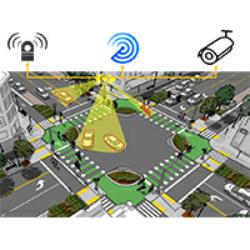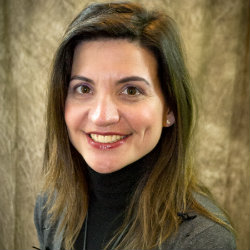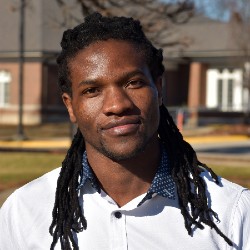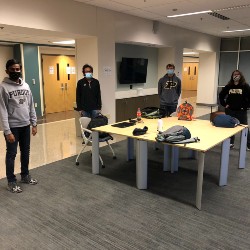Transportation and Infrastructure Systems Engineering
As a branch of civil engineering, transportation engineering has a history that is long and illustrious and a future that is full of promise. The National Academy of Engineering has identified restoring urban infrastructure and implementing smart mobility as grand challenges. We need coordinated approaches to tackle transportation issues by integrating car, rail, bus, truck, walking and bicycling to meet sustainability goals. Currently, we see how smartphones have enabled ride sharing services such as Uber and Lyft, while taxis and GPS-equipped cars and trucks are providing massive amounts of data that was unimaginable a few years back. Before long, it may be common to have vehicles are talking to infrastructure (V2I) and vehicles talking to each other (V2V). Traffic flow with automated vehicles is expected to be much safer and more efficient than with human drivers.
The journey to that future will be fascinating and challenging. The safe and efficient movement of people and goods relies on infrastructure. Highways, airports, railroads, waterways and pipelines need to be planned, designed, operated, and maintained. Purdue's Transportation and Infrastructure Systems Engineering faculty offer a wide range of classes, research facilities, and experiences. Their efforts will have noticeable impacts on challenges such as:
- Asset management
- Data acquisition and analytics
- Emergency response
- Energy
- Freight Transportation and Logistics
- Environment
- Smart Mobility
- Sustainability
- Urban infrastructure
The award-winning Purdue Student Chapter of the Institute of Transportation Engineers introduces students to the transportation profession and fosters a close association of students with practicing engineers, educators from other institutions, and local and national chapters of ITE.
Spotlights
May 6, 2021
CE senior Steven Rogers has been named a recipient of the 2021-2022 Edward J. Cox Memorial Transportation Scholarship Award. The award is presented annually by the Indiana Section of the Institute of Transportation Engineers.
May 6, 2021
PhD student Bortiorkor "Naa" Alabi has been named a recipient of the 2021-2022 Edward J. Cox Memorial Transportation Scholarship Award. The award is presented annually by the Indiana Section of the Institute of Transportation Engineers.
April 25, 2021
Purdue University is poised to be the first to roll out TScan - an innovative, fully automated scanning system for acquiring traffic microscopic data at road intersections.
April 25, 2021
Purdue University is a partner in a $9.95M U.S. Department of Transportation project aimed at demonstrating the safety and mobility potentials of a next-generation traffic control system. Called “smart intersections,” the technology is capable of gathering and transmitting information in real time to connected and automated vehicles (CAVs).
April 24, 2021
Konstantina (Nadia) Gkritza, Professor of Civil Engineering and Agricultural and Biological Engineering, has been recognized as a Purdue University Faculty Scholar. The University Faculty Scholars Program recognizes outstanding mid-career faculty who are on an accelerated path for academic distinction.
April 24, 2021
Congratulations to CE graduate students Abdullah Nafakh and Isaiah Mwamba for receiving an honorable mention in the Purdue Climate Change Research Center (PCCRC) video competition. Their entry in the contest is titled, "Infrastructure and the Environment: A Love-Hate Relationship."
April 23, 2021
Wejo, the leader in connected vehicle data, will host a panel discussion during National Work Zone Awareness Week (NWZAW) 2021 exploring how DOTs around the U.S. can tap into connected vehicle data to create safer work zones and save lives. The session, titled, "Connecting the DOTs: How Connected Vehicle Data Enables Work Zone Safety," will feature experts from Purdue University, Google, and the Indiana Department of Transportation (DOT), and will take place virtually on April 28, 2021 at 2pm ET.
April 13, 2021
Data engineers at Purdue University are using a wealth of connected vehicle data to help improve highway safety and efficiency while laying the groundwork for the ultimate edge device, the autonomous vehicle.
April 13, 2021
Since launching in September 2020, the Center for Innovation in Control, Optimization and Networks (ICON) hasn’t let the COVID-19 pandemic hamper its goals.
April 9, 2021
The Purdue University Board of Trustees on Friday (Apr. 9) ratified the appointment of Satish Ukkusuri as the Reilly Professor of Civil Engineering.
April 9, 2021
The Third Annual Next-Generation Transport Systems (NGTS–3) 2021 Conference will be held virtually May 24–28, 2021. It is organized and run by engineering students within the Center for Connected and Automated Transportation (CCAT) at Purdue.
April 7, 2021
A new graduate-level course that addresses the applications of machine learning and artificial intelligence (ML/AI) in connected and autonomous vehicle (CAV) operations has taken shape in the Lyles School of Civil Engineering.
April 7, 2021
Big data from connected vehicles can provide powerful insights to help government agencies improve the safety and efficiency of their surface transportation systems. CE’s Darcy Bullock is making big strides in using this connected vehicle data.
January 31, 2021
Ph.D. candidate Theodora Konstantinou has been awarded the 2019-2020 Greater Indianapolis Women's Transportation Seminar (WTS) Chapter Helene M. Overly Memorial Scholarship. The scholarship recognizes an outstanding graduate female in the transportation industry and academia.
January 7, 2021
Congratulations to Abdullah J. Nafakh for receiving the annual University Transportation Centers (UTC) Program's Outstanding Student of the Year Award. The award was given by the U.S. Department of Transportation's University Transportation Centers Program and the Council of University Transportation Centers (CUTC).
October 29, 2020
CE master's student Isaiah Mwamba has been awarded a fellowship by the Dwight David Eisenhower Transportation Fellowship Program (DDETFP) for the 2020-2021 academic year. The DDETFP is administered by the Federal Highway Administration (FHWA) Universities and Grants Program and awards competitive fellowships to students in transportation-related disciplines.
October 26, 2020
Congratulations to the Purdue Institute of Transportation Engineers (ITE) Traffic Bowl Team on winning the 2020 ITE Virtual Collegiate Traffic Bowl Grand Championship! The traffic bowl is an annual competition among ITE student chapter teams, and uses transportation planning and engineering topics for the clues, questions and answers.
October 21, 2020
CE master's student Sarah Adsit has been awarded a fellowship by the Dwight David Eisenhower Transportation Fellowship Program (DDETFP) for the 2020-2021 academic year. The DDETFP is administered by the Federal Highway Administration (FHWA) Universities and Grants Program and awards competitive fellowships to students in transportation-related disciplines.
October 21, 2020
CE master's student Arianna Rambaram has been awarded a fellowship by the Dwight David Eisenhower Transportation Fellowship Program (DDETFP) for the 2020-2021 academic year. The DDETFP is administered by the Federal Highway Administration (FHWA) Universities and Grants Program and awards competitive fellowships to students in transportation-related disciplines.
October 9, 2020
In the United States, the transportation sector accounts for 28% of energy consumption, 70% of petroleum use and 29% of greenhouse gas (GHG) emissions. It is argued that as much as an 80% reduction in worldwide emissions may be needed to stabilize the atmospheric concentration of GHG over the next three decades — at the same time that our nation’s infrastructure is aging, and in need of trillions of dollars in repairs and reconstruction.


















